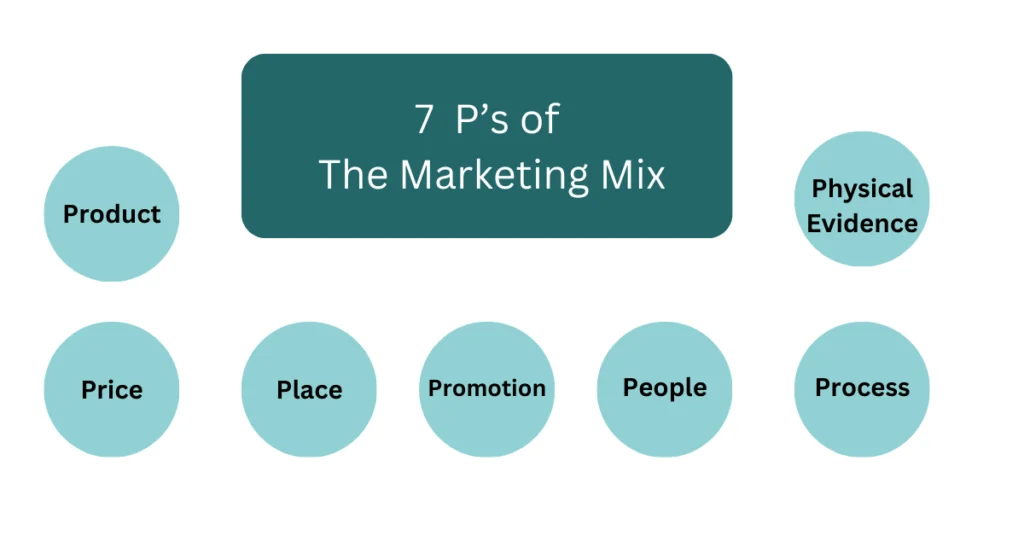Marketing strategies come and go, but one that stands the test of time and continues expanding is the marketing mix. This framework has been a staple in the marketing industry for decades.
The marketing mix comprises the 7 Ps – Product, Price, Place, Promotion, People, Process, and Physical Evidence. Each element plays a role in creating a strong brand identity, reaching your target audience, and, in a healthcare context, delivering exceptional patient experiences.
Throughout this guide, we’ll explore the 7 Ps in detail and share practical insights and examples for the healthcare industry.
First, a little history of how the marketing mix came about and has expanded from its original 4 Ps to the more comprehensive 7 Ps marketing mix strategy we use today.
From 4 Ps to 7 Ps
The marketing mix dates back to the 1950s when marketing specialist Neil Borden first introduced the term during a speech. However, it was marketing professor E. Jerome McCarthy who refined Borden’s ideas and created the 4 Ps of marketing: price, product, place, and promotion.
McCarthy proposed that by strategically combining these four elements, businesses could identify their core customers and determine the most effective ways to reach them. He further elaborated on this concept in his 1960 book, “Basic Marketing: A Managerial Approach.”
Bernard H. Booms and Mary J. Bitner expanded the marketing mix in 1981 by adding three more Ps: people, physical evidence, and processes.
Though its roots are in traditional marketing, the marketing mix now operates in a predominantly online environment. Applying the 7 Ps to digital marketing has proven to be just as successful as it was for traditional marketing.
By using a digital marketing mix, businesses can now reach and engage their target audience through online channels. This includes social media platforms, search engine optimization (SEO), content marketing, and email marketing campaigns.
The 7 P’s Marketing Mix Elements
The 7 Ps of the marketing mix work together as a comprehensive strategy to help businesses best target, reach, and engage their desired audience. By carefully considering and optimizing each element in the mix, a cohesive and powerful marketing approach can be achieved that drives results.
#1. Product
To be clear, the term ‘product’ can be used interchangeably with ‘service,’ so the various treatments, procedures, and care options you offer will come under this banner. The marketing objectives for a product or service to focus on should include:
Core Service -This is your primary service, such as medical consultations, diagnostic tests, or surgical procedures. It is the main reason patients seek your expertise. It’s important to clearly define your core service for the marketing mix, as it forms the foundation of your healthcare practice and guides the development of your marketing strategies.
Additional Services – These are the extra features and benefits that complement your core service, such as extended office hours, telemedicine options, or patient education resources. These extras can help differentiate your practice from competitors and improve patient satisfaction.
Branding – Develop a strong brand identity for your healthcare practice that reflects your values, mission, and the quality of your services. A well-established brand can help build trust and loyalty among your patients. Your branding needs to be consistent across all touchpoints, including your website design, marketing materials, social media presence, and patient interactions.
#2. Price
Pricing is an important element of the marketing mix, as it directly impacts the perceived value of your healthcare services and can influence patient decision-making.
Competition – Research the pricing strategies of your competitors in the local healthcare market. You don’t necessarily need to match their prices, but it can help you better position your services by adjusting your pricing strategy to remain competitive.
Perceived Value – Consider the perceived value of your services through the eyes of your patients. Patients are often willing to pay more for services they believe are of higher quality, have unique benefits, or are from a reputable and experienced healthcare provider.
Transparency – Be clear about your pricing and any potential add-on costs. Communicate your fees to patients upfront to avoid surprises and maintain trust.
#3. Place
In the marketing mix, “place” refers to the distribution channels and locations where your healthcare services are and how patients can access them.
Visibility – Your practice should be easy to find online and off. Include clear signage, prominent placement in a medical office building or retail center, and up-to-date online information with accurate contact information, opening and closing times, and directions.
Telemedicine – Consider incorporating telemedicine options into your practice in light of the growing demand for remote healthcare services. This can expand your reach, improve patient convenience, and set your practice apart from competitors who may not offer virtual consultations.
Online Presence – Your website and online profiles serve as virtual “places” where patients can learn about your services, book appointments, and interact with your practice. With the majority of people now searching online for local healthcare providers, you need a user-friendly, informative website optimized for search engines. This includes having a mobile-responsive site, clear calls-to-action, and engaging, informative content.
#4. Promotion
Promotion is a major element of the marketing mix, as it encompasses the various strategies and tactics used to communicate the value of your healthcare services to your target audience.
Social Media Marketing – Your online marketing efforts should allocate resources to the social media platforms that are most frequented by your target market. Engage with patient inquiries and comments, and consider running targeted social media ads to reach new potential patients.
Content Marketing – Content is still king for any successful marketing strategy. As a healthcare provider, the website content you share should be informative but also clear and easy to understand.
Search Engine Optimization (SEO) – Optimize your website for relevant keywords to improve your search engine rankings and make it easier for patients to find your practice online. This includes optimizing your website’s structure, meta tags, and content, as well as building high-quality backlinks from reputable sources.
Pay-per-click (PPC) – Invest in paid search advertising on search engines like Google to drive targeted traffic to your website. Create compelling ad copy to encourage potential patients to take action, such as scheduling an appointment or requesting more information.
Email Marketing – Build an email list and send regular newsletters featuring health tips, practice updates, and promotional offers. Segment your email list based on patient preferences and interests to deliver targeted, personalized content that resonates with each group.
#5. People
In the healthcare industry, the people element of the marketing mix applies to all those individuals who interact with patients and contribute to their overall experience.
Healthcare Providers – Your healthcare providers, such as doctors, nurses, and specialists, will be highly skilled, compassionate, and committed to delivering exceptional care. Encourage ongoing training and development to keep their skills sharp and up-to-date with the latest medical advancements.
Support Staff – Your support staff, including receptionists, medical assistants, and administrative personnel, also play a vital role in the patient experience. They are often patients’ first and last points of contact, so they must be friendly, knowledgeable, and efficient in their roles. Regular training should be encouraged so that support staff members are trained to handle patient inquiries and concerns with professionalism and empathy.
External Partners – Consider the external partners and vendors you work with to deliver care and services. It might include companies like Practis, an Onspire Health Marketing company, that you team up with to provide quality medical marketing services. These partners should share your commitment to quality and patient satisfaction.
#6. Process
The “process” element of the marketing mix is all about the systems, procedures, and workflows that shape the patient experience from start to finish. In healthcare, this will be everything from appointment scheduling and patient intake to treatment protocols and follow-up care.
Customer Journey – Map out the entire patient journey, from the moment they first learn about your practice to post-treatment follow-up. Identify potential pain points or areas to improve customer satisfaction at each stage of the journey.
Appointment Scheduling – Implement a user-friendly appointment scheduling system whereby patients can easily book, reschedule, or cancel appointments online or by phone.
Patient Intake – Simplify your patient intake process using HIIPA-compliant secure digital forms and automated reminders. This can reduce paperwork, minimize wait times, and help maintain accurate and up-to-date patient information.
Quality Assurance – You can establish processes to monitor and evaluate the quality of your procedures and where they can be improved. This can include regular audits, patient surveys, and performance metrics.
#7. Physical Evidence
The seventh and final element of the marketing mix is physical evidence, the tangible elements that patients interact with in your healthcare practice.
Facility Design – The design and layout of your healthcare facility is the most important piece of physical evidence. Consider color schemes, artwork, and furniture choices that create a calming and healing environment. Incorporate biophilic design elements, such as natural light and plants, to promote well-being.
Waiting Areas – Pay special attention to your waiting areas, as this is where patients often spend a reasonable amount of time. Comfortable seating, relevant reading materials, and entertainment options like televisions or Wi-Fi access can all add to a great patient experience.
Signage and Branding – Use clear and consistent signage to reinforce your brand identity. Your branding should be visible on everything from business cards and appointment reminders to medical equipment and employee uniforms.
Technology – Patients use a mouse, keyboard, or touchscreen to navigate your website, complete forms, or interact with patient portals and apps. This physical interaction makes technology a tangible part of the patient experience, even digitally. The design, functionality, and ease of use of these digital tools contribute to the overall impression of your practice.
Wrapping Up
You likely already implemented many elements of a successful marketing mix; you just need to add the missing pieces. By carefully considering and fine-tuning each element of the mix, you can create a patient-centric approach that sets your practice apart from competitors and drives long-term success.
However, implementing effective marketing strategies and running a busy practice can be challenging. That’s why many healthcare providers turn to us. At Onspire, we’ve built our reputation on 25 years of experience in healthcare, offering solutions that include award-winning medical web design, content, and marketing.
Our team of experienced healthcare marketing professionals can help you use the power of the 7 Ps of marketing to grow your practice and deliver exceptional patient experiences.








